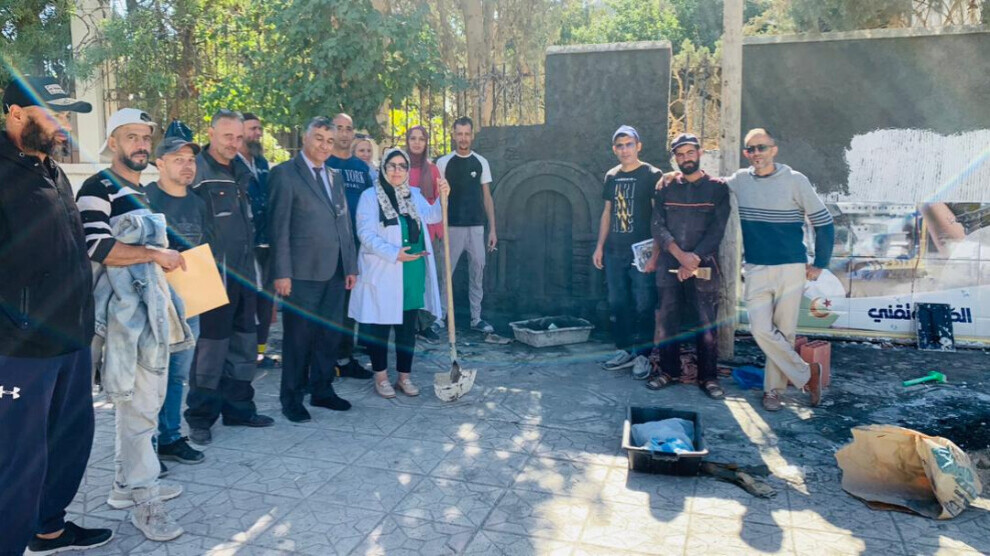An Algerian Woman Breathes Life into Stone and Concrete
Fouzia Ghabash is one of the Algerian women who have proven that the field of construction is not too difficult for women — a woman can work in it with professionalism and skill.

Rabia Khreiss
Algeria - Fouzia Ghabash practices “engraving on stone” and “painting with a spray gun using oil-based paints,” but her work stands out with a unique and distinctive style that reflects her personality and artistic identity.
Fouzia takes on multiple roles, including professional training in construction, architectural, and civil engineering fields. At the same time, she is a visual artist and writer, born in 1982 in the ancient city of Tazoult in Batna Province, the capital of the Aurès region, located 425 km southeast of Algiers.
She has several published works and began her academic journey with a certificate in fabric painting. She is a graduate of the School of Fine Arts in her hometown and holds the title of “Arab Researcher of Excellence” from the UK. She has also earned the title of “Ambassador of Algerian Fine Art” and is a certified trainer from the American Institute for Professional Studies.
Fouzia has participated in many national and international conferences and symposiums, including the International Creativity Conference in Egypt. She also took part in the Arab Researcher Project in the UK, where she received the title “Arab Researcher of Excellence.”
Combining Practical and Literary Dimensions
Fouzia Ghabash is currently working on a new design for the “Tabna” wedding hall in the city of Batna. About that, she says:
“I combine the practical and literary aspects in all my work. I document everything in photos, with the main goal of publishing books in the field.”
For example, she has published several books for middle school education, including “Secrets and Techniques of the Pencil” for first-year students, “Secrets and Techniques of Watercolors” for third-year students, and a book titled “Test Your Intelligence” (Parts 1 and 2) for middle school learners.
After joining a vocational training center as a specialized instructor in painting and decoration, she published four training guides for apprentices, which are now officially approved by the Ministry of Vocational Training.
Being from Tazoult — a Roman military city located 10 km from Batna and one of Algeria’s most important archaeological sites — Fouzia strives to infuse her cultural and historical heritage into her creations. She says she seeks to “capture the symbols and motifs that preserve the heritage of her region and all the places she visits.”
She adds: “Every city I visit, I create art that reflects its unique heritage.”
For example, in her hometown Tazoult, she carves Roman symbols, as the city was once the first capital of the Roman province of Numidia. She deliberately chooses colors that reflect the spirit of the region and convey deep cultural and symbolic meanings.
Heritage-Inspired Projects
The ambitious artist and architect has completed many projects, such as the Bachmul Roundabout Project and a sculpture at the entrance to Tazoult, inspired by Amazigh and Aurès heritage. She also created a miniature model of Baloul Castle — a historical Amazigh fortress in the Aurès region of Batna, built about 14 centuries ago. The castle is known for its exceptional architectural design.
Her artistic mark is also visible in many public parks, gardens, and city squares.
Crowning her long journey of research, studies, and field achievements, Fouzia Ghabash launched the Professional Fingerprint Project under the slogan “Together We Meet… With the Fingerprint We Rise.”
She explains that the project “includes everyone — instructors, trainees, and even people with disabilities — to leave a creative mark in every place we visit.”
“We have visited more than ten cities so far, and our latest project was completed at the headquarters of the Ministry of Vocational Training and Education,” she adds.
The Professional Fingerprint Project is a national educational and training initiative that promotes the transfer of knowledge and practical skills through free training courses in various fields for unemployed youth. It has been adopted as an official strategy within the vocational training sector.
When asked about the main motivation behind her entry into this field — especially as she now trains men — Fouzia answered: “When I used to sit in public parks and squares, I noticed that modern construction sadly lacked aesthetic and urban harmony. So I always asked myself: Why don’t we turn concrete from a lifeless material into something alive? Why not create stone sculptures that help preserve Algerian heritage and history? That’s why I always launch training courses — even for prisoners. In fact, my first collaborative project was with inmates at Tazoult Prison.”
